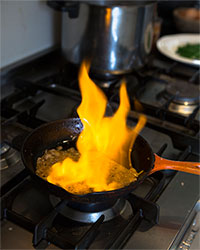Recipe: steak au poivre


Roula Khalaf, Editor of the FT, selects her favourite stories in this weekly newsletter.
Albert Roux once maintained that if he wanted to assess the ability of a young chef, he would ask him to fry an egg. The care with which he or she would break the shell, the low temperature at which he would cook the white so that it did not toughen, the manner in which he would gently baste the yolk and end up with a perfectly cooked example would tell Roux all he needed to know. If a fried egg was the 11-plus of cookery, I think a peppered steak might be a good GCSE or even A-level.
There are a number of trucs – French for something between a trick and a technique – involved in the operation. First, the meat should be brought to room temperature well in advance of cooking – this will drastically shorten the cooking time. Second, the peppercorns must be no more than broken: a crafty cook will sieve the ground corns and retain what is left, keeping the finely ground pepper for some other use.
If finely ground pepper is used on the steak, it will burn and make the dish very bitter.
The meat should be salted before cooking (frowned upon by some but essential for flavour in my book) – and the cook must colour the meat on all sides in a mixture of oil and butter and cook it to just over blood heat in its centre. Then he can let it rest in a warm place while he makes the sauce. If the cooking of the meat will test his technical ability, the sauce will test his sense of taste. It must be unctuous without being cloying and will need just a hint of acidity and bite to do the steak justice.
I am assuming that you will want your steak rare. It is, dare I say it, comme il faut, although I am always willing to be guided by the customer in this regard. I was much heartened this week when we cooked beef Wellington for a party of 102 people. The beef was cooked to a beautiful rosy rare and we sent it out, anticipating a few requests for some to be more cooked. It is a measure of how far we have come gastronomically – or perhaps how orthodoxy has taken hold – that we received no such request and every plate was clean.
Steak au poivre
Ingredients
Always best as a dinner for two: considering the expense, this is perhaps wise. Some people prefer using white peppercorns: it is a matter of taste.

2 fillet steaks, each weighing at least 225g
2 tbs black peppercorns
40g unsalted butter
30ml brandy
50ml white wine
100ml stock (beef or chicken, quite strong)
50ml double cream
A squeeze of lemon
● Take the meat out of the fridge and bring to room temperature over an hour. Pound the peppercorns in a mortar until they are all broken – no more – and then sieve out the dust, saving this for another use. Great care should be taken that they are merely broken.
● Salt one side of the fillets and then place this side down into the peppercorns, pushing down well so that the pepper adheres to the meat. Melt half the butter in two or three tablespoons of oil in a small frying pan. Once the butter is foaming, place the steaks pepper-side down in the pan. Let the meat colour well and do not be tempted to move it around for a couple of minutes. Once nicely browned, salt the exposed side of the steak, turn them and colour the reverse. Once they are rare – just over blood heat (42C) if tested with a skewer drawn from the middle of the meat – remove the steaks from the pan and let them rest on a plate in a warm place, ideally a warming oven.
● Pour the fat from the pan and return it to a high heat. Pour in the brandy and set it alight. Pour in the wine immediately and scrape up any caramelised juices with a wooden spoon. Allow the alcohol to evaporate to a syrupy glaze and then pour in the stock. Reduce this quickly by half before adding the cream. Whisk this into the sauce and reduce slightly. Salt to taste, add a squeeze of lemon and then whisk in the remainder of the butter and any juices from the resting steaks. Serve the steaks with plenty of sauce, green beans and some good chips.
——————————————-
Rowley’s drinking choice
Pepper won’t hurt good wine but the richness of the sauce will require it to be matched with a bit of acidity and freshness. Older wines may therefore suffer a little. A Chianti or Brunello, five to seven years old, might be ideal.
——————————————-
Rowley Leigh is the chef at Le Café Anglais
Comments